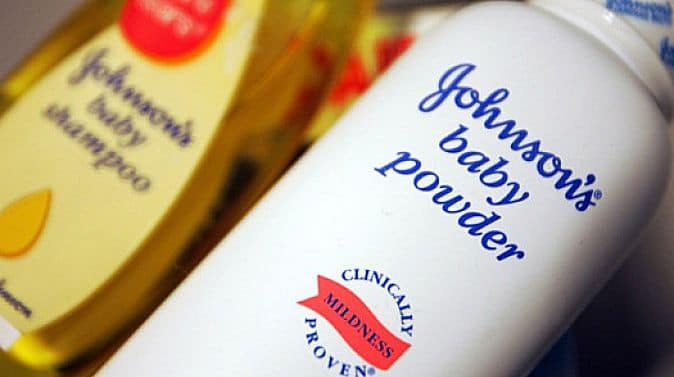
Sentence imposed by the Los Angeles court on the pharmaceutical multinational
FABIO DI TODARO – Published on 22/08/2017 – THE PRESS
 The figure is record-breaking: 417 million dollars. This is the amount of the compensation sentence imposed by the Los Angeles court on the pharmaceutical multinational Johnson & Johnson. According to the judges, the talc used for decades by the 63-year-old Eva Echeverria would be responsible for the ovarian cancer which she has been ill with for some time now. The company was found guilty of failing to inform consumers and regulators of the carcinogenicity of its products, despite having known about them since 1980.
The figure is record-breaking: 417 million dollars. This is the amount of the compensation sentence imposed by the Los Angeles court on the pharmaceutical multinational Johnson & Johnson. According to the judges, the talc used for decades by the 63-year-old Eva Echeverria would be responsible for the ovarian cancer which she has been ill with for some time now. The company was found guilty of failing to inform consumers and regulators of the carcinogenicity of its products, despite having known about them since 1980.
It is not the first such conviction to be recorded in the United States. For the same reason, in May, a claim for damages equal to 55 million dollars was imposed against Johnson & Johnson. But the bill could rise again, since there are more than two thousand lawsuits filed against the company. The «Baby Powder» talcum powder made by the multinational almost always ended up in the dock, which at the end of each proceeding in any case announced its willingness to appeal against the first instance sentences.
Claims for over $300 million
The news received wide coverage in the main US and English media: from «New York Times" at the "BBC». On the other hand, the topic of the alleged carcinogenicity of talc has been recurring for several years now: at least since the beginning of 2016, when Johnson & Johnson was sentenced to pay the first compensation for an amount equal to 72 million dollars, to be paid to the family of a woman who died before the sentence was pronounced.
At the moment, overseas compensation claims would already exceed the 300 million mark. Many citizens are turning to the judges after using talcum powder on their children's skin for years, in order to prevent chapping and refresh their underwear before putting it on. The suspicion is that the product - a natural mineral composed of magnesium, silicone, oxygen and hydrogen - can reach the ovary through the external genitalia and determine a state of constant inflammation. But at the moment the scientific community does not seem to be convinced of the existence of this correlation.
What does science say?
 Just over a year ago, after the delivery of the first sentence, Carmine Pinto, director of the oncology complex structure of the Irccs Santa Maria Nuova in Reggio Emilia and national president of the Italian Association of Medical Oncology (Aiom), said «almost certain of the impossibility of seeing in Italy a scenario similar to the one emerging in the United States». A statement that referred above all to the possible presence of asbestos in products for sale. The problem would therefore not be linked to the talc itself, but to the possible presence of asbestos fibers in the packages on the market. A risk which, according to what has been declared on several occasions by the companies, would have been reduced starting from the '70s: with the elimination of asbestos from the panel of ingredients.
Just over a year ago, after the delivery of the first sentence, Carmine Pinto, director of the oncology complex structure of the Irccs Santa Maria Nuova in Reggio Emilia and national president of the Italian Association of Medical Oncology (Aiom), said «almost certain of the impossibility of seeing in Italy a scenario similar to the one emerging in the United States». A statement that referred above all to the possible presence of asbestos in products for sale. The problem would therefore not be linked to the talc itself, but to the possible presence of asbestos fibers in the packages on the market. A risk which, according to what has been declared on several occasions by the companies, would have been reduced starting from the '70s: with the elimination of asbestos from the panel of ingredients.
Asbestos causes the eventual inhalation of talc to increase the risk of the onset of pleural mesothelioma or lung cancer. "But at the moment there is no evidence that demonstrates the dangers of talc," added Pinto, recalling that since 1994 it has been forbidden in Italy to manufacture products containing asbestos fibres.
Purely as a precaution, this is the recommendation that can be read in a publication on ovarian cancer prepared by the Umberto Veronesi Foundation , «it is advisable not to use talcum powder in intimate areas: vulva, vagina and perianal area. Its use in other parts of the body is not associated with the risk of developing ovarian cancer or in other parts of the body.
Twitter @fabioditodaro
Related news: Ovarian cancer: Johnson & Johnson will have to pay 55 million dollars
Johnson & Johnson to pay $72 million to the family of a woman who died of ovarian cancer
Johnson & Johnson Makes Historic Commitment to Remove Cancer-Causing Chemicals from All Its Products
Asbestos in commercial cosmetic talcum powder as a cause of mesothelioma in women
Genital use of talc and risk of ovarian cancer: a meta-analysis





